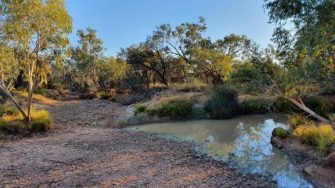
Date: Wednesday, October 9, 2019
Project: Eastern Australian Waterbird Survey
Observers: John Porter & Shannon Dundas
Pilot: Tim Dugan
Awaking to cooler temperatures is a welcome relief but minor engine problems that surfaced the previous day mean we will have to return to Sydney a day earlier than planned. Refuelling also brings a few challenges in the form of a recalcitrant fuel pump and an unstoppable hose reel, which delays our departure a little - but we eventually depart Thargomindah and head west along Band 6.
Fuel prices can be high in remote areas.
Most of the wetlands this morning are small clay pans and lignum swamps. Surprisingly, some have water persisting after patchy thunderstorms passed through some weeks ago. There are low to moderate numbers of waterbirds – grey teal, pink eared ducks, black ducks, spoonbills, egrets, black tailed native hens, swamphens and whiskered and gull billed terns. Then we arrive at the Bulloo river floodplain – here at its lower end the floodplain has deep channels, billabongs, waterholes and vast areas of shallow lignum and Black box swamps. It’s a quintessential desert river with Red gum, Black box, Coolibah and Yapunyah trees lining the channels.
Bulloo River waterhole near Thargomindah.
Counting conditions are excellent and we enjoy spending some time weaving back and forth to follow the water in the deeper channels – there are pelicans, darters flopping from trees into the water and egrets and spoonbills.
Red sand meets grey clay of the Bulloo river floodplain
Following the river as it runs west south west we arrive at a huge flood out area where water spreads out across thousands of hectares of lignum and open clay pan – there is a surprising amount of water here at the moment and there are thousands of waterbirds – mainly pink-eared ducks, grey teal, black duck, spoonbills, brolgas, egrets, herons, black tailed native hens, swamp hens and lapwings.
Bulloo overflow lakes.
Bulloo overflow lakes
We finish counting the band and head to Tibooburra for a break – the landscape is badly drought affected with only c. 83mm rainfall this year – about half the amount for an average year. Friendly staff from Tibooburra NPWS give us a lift to & from the airstrip into town for lunch – then it’s back into the skies to head directly back to Bankstown. On the way, we pass high over the Paroo overflow lakes and Paroo-darling National Park; most of the lakes are dry but Mullawoolka Lake stands out with some residual water remaining - but it looks to be drying rapidly.
Paroo Overflow lakes and Mullawoolka Lake with some water still remaining – all the other lakes are dry.
